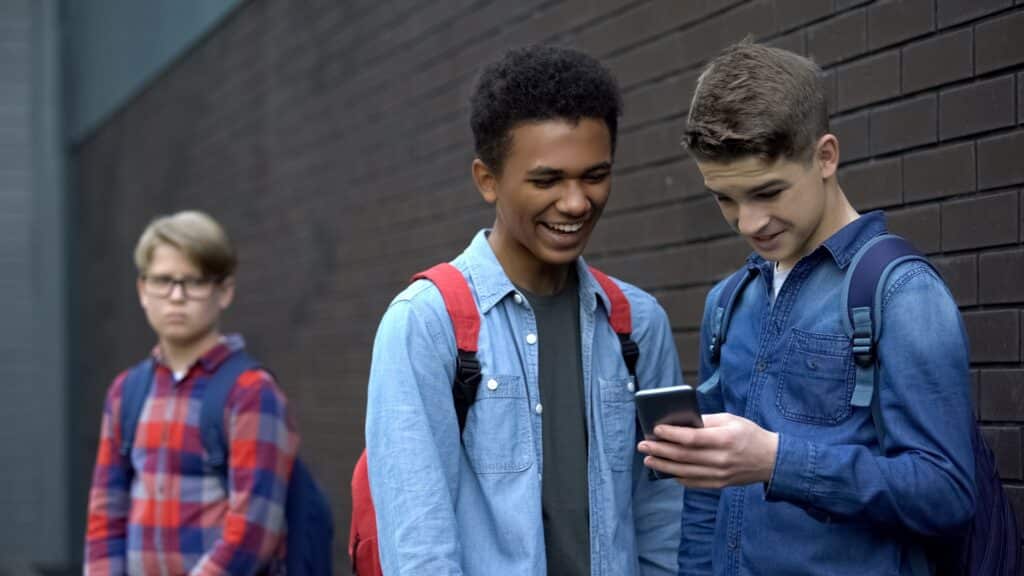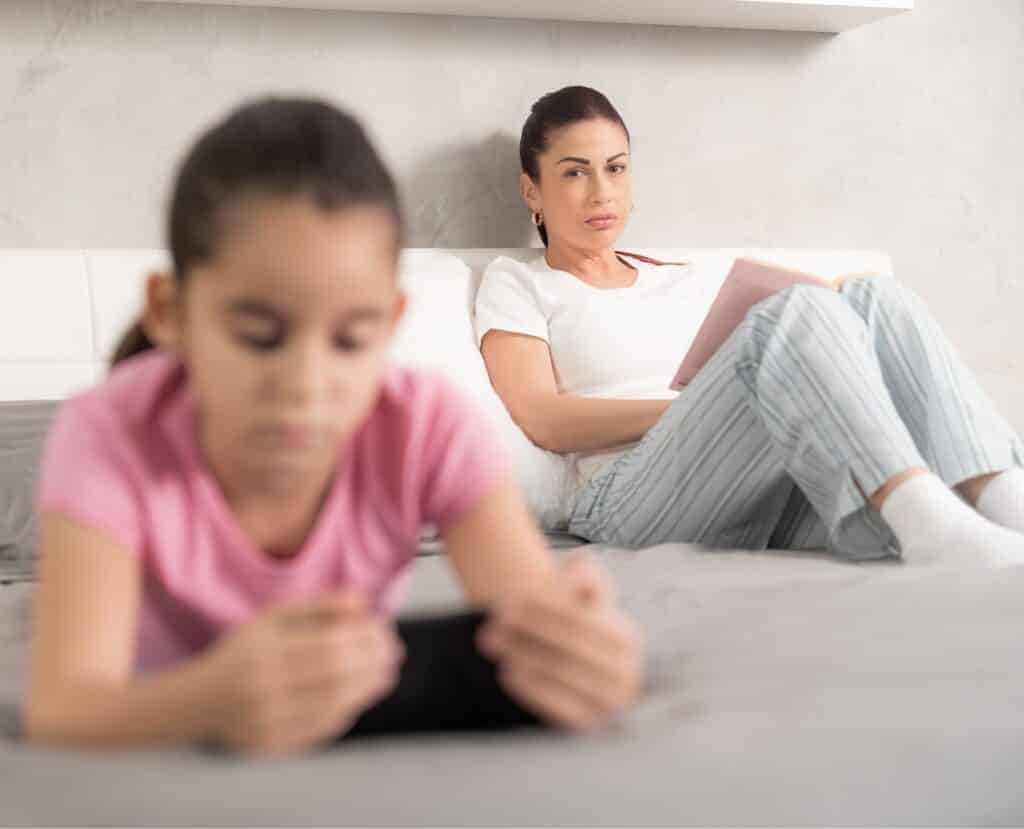WhatsApp has over 2 billion users.2 Statistically, there is a pretty high chance your child is one of them. But what do you know about this popular messaging app?
Many parents are in the dark when it comes to WhatsApp.
This guide will help you outline the app’s features, benefits, and risks so you can make informed decisions about if and how your kids will use it.
What is WhatsApp?
WhatsApp is a messaging platform that is becoming increasingly popular with kids.
It’s very similar to text messaging, but a few differences make it so popular.
Texting vs. WhatsApp
Texting and WhatsApp share many similarities, but they have some differences too. Here’s how they compare in a nutshell:
WiFi usage
WhatsApp uses WiFi instead of a wireless network service to send and receive messages.
This can be useful in places with poor phone service or when communicating across international lines where SMS messages can rack up expensive phone bills.5
However, while your content is encrypted, WhatsApp itself can track usage and location for data analysis.6
Group chats
WhatsApp also is useful for communication between large groups of people.
While most phones limit the number of contacts in a group chat to somewhere between 20-32, WhatsApp allows for groups of 256 people.5
With the possibility of large group communications, the risk of exposure to online grooming increases for our kids.
Voice and video calls
WhatsApp offers more than just text messaging features. They also offer free voice and video calls.
End-to-end encryption is built into the app, so messages and calls are secure—no one can read or listen to the messages besides people in the chats.5
This could also mean that parents may not know what their children are saying or whom they are talking to.
Media sharing
The messaging service lets users share documents, pictures, and videos up to 100 MB in size.5
When multiple communication mediums are available, our children’s exposure to risk increases.
What are the Dangers?
Under certain circumstances, WhatsApp can be useful for staying in touch with friends and family.
It appears safe and straightforward, but it poses a danger to children.
For parents to protect their families and make informed decisions about their digital lives, they need to know about the risks associated with this app.
Unmonitored use
WhatsApp presents many of the same threats to families as email or non-filtered text messaging.
However, while parents often check their children’s texts and emails regularly, WhatsApp is one platform many don’t know about and don’t monitor.
The lack of adult supervision increases the potential dangers of the app by decreasing the likelihood that a parent will find out about problems and intervene.
Some kids even use WhatsApp solely for this reason—their parents are less likely to oversee it.1

Access to inappropriate content
There is no chat filter available on WhatsApp. This means users can send each other whatever they want.
Dirty jokes, violent videos, pornographic images, vulgar messages, links to adult websites—it’s all fair game.
With no chat filter, WhatsApp users can share anything they want—from distasteful jokes to adult websites.
Kids can also search online to find group chats dedicated to sharing adult content. Searching “WhatsApp directories” is one way to do this.
By doing so, kids can find thousands of links to groups about hundreds of topics, many of which exist solely to share pornography.
There is still hope even if your child has gone down a dark rabbit hole. Learn tips on what to do if your child has been exposed to inappropriate content online.
Stranger Danger: Are There Predators on WhatsApp?
To send someone a message on WhatsApp, you need to know their phone number and add them to your device’s contact list.
Despite this, predators, hackers, and spammers are tricky and find various ways to share messages with kids.
Group chats, for instance, present an opportunity for predatory contact. Anyone in a group message can view all the other members’ contact information.
In other words, if your child is in a group chat with a few of their friends and one of them adds his uncle to the chat, the uncle can now privately contact any group member.
WhatsApp text threads can include up to 256 people.
The bigger the size of the group chat, the more danger it presents to children.
Understanding the intentions of even one person is a complex task for a child, so the enormous allowance for 255 other people on the thread poses a huge risk.
Furthermore, kids who join random public group chats online open themselves up to being contacted by an almost unlimited number of strangers who may misrepresent their identity.
Predators always obscure their true identity and use these opportunities to prey upon children.

Online grooming
Predators often use WhatsApp to groom their victims. They might meet a child on a computer game, a social media site, or some other location and establish a friendship. The predator will then suggest connecting on WhatsApp.
Since WhatsApp doesn’t offer chat filters or prohibitions against inappropriate content, once the predator has connected there, they can say and share anything they want.
Because WhatsApp uses WiFi instead of phone service, predators can communicate across international lines.
Disappearing messages
This feature allows to be automatically deleted after 24 hours, 7 days, or 90 days.
While you can turn this feature off, there is nothing to stop your child from immediately turning it back on when you walk away.
Disappearing messages are dangerous because they lead children to believe they can send intimate photos, videos, or messages they wouldn’t normally send—thinking the message will soon be deleted from the internet permanently.
What these kids don’t understand is any message is a screenshot or download away from living online forever.
Their private messages can resurface anytime and be used for sextortion and harassment.

Cyberbullying
Cyberbullying can take many different forms, including name-calling, spreading rumors, sharing nude photos, or encouraging self-harm or suicide.4
Since images, videos, and documents can be shared on WhatsApp, it is the perfect place for bullies to harass their victims.
Another type of cyberbullying that can be particularly dangerous is “doxing.” This is where the bully posts their victim’s personal information online in a way that proves harmful or embarrassing.4
A bully can post someone’s WhatsApp number somewhere online, and the child can receive hundreds of hurtful messages from people they don’t know.
Learn more how to deal with a bully.
No parental controls
WhatsApp doesn’t offer any parental controls. While users can turn on certain features to protect their privacy, these features cannot be locked with a PIN or password.
Because of this, a child could change any setting at any time.
WhatsApp Privacy Features
- About: A place where users can post a brief description of themselves. You can determine who can read your description by choosing from a range of options between “Nobody” and “Everyone”.
- Fingerprint lock: Set up the ability to lock the app with your fingerprint so only you can open it.
- Last seen: WhatsApp lets users see when other users last accessed the app. You can set who can see this status to a range of options between “Nobody” and “Everyone”.
- Live location: Determine whether the app can track your location. Each individual chat allows you to choose whether you want others in the chat to see your location.
- Profile photo: Limit who can see your profile picture. Settings include a range of options between “Nobody” and “Everyone”.
What is WhatsApp Rated?
The Apple Store rates WhatsApp appropriate for children 4+, and the GooglePlay Store rates it E for everyone.
Still, these ratings only consider the content that WhatsApp itself puts on the app. The rating doesn’t consider the material that can be shared between users.
Since WhatsApp itself doesn’t post any content—it simply provides a messaging service—the app has a low rating despite all of the dangers it presents to kids.
Is WhatsApp Safe for Kids?
WhatsApp is not safe for children. It presents too many opportunities for kids to come across harmful content or to be contacted by online predators.
WhatsApp has even caught the attention of the National Center on Sexual Exploitation (NCOSE).
In their 2022 Dirty Dozen List, an annual list of twelve mainstream entities enabling sexual abuse, the NCOSE labeled WhatsApp as a “primary place for grooming, sextortion, child sexual abuse materials, [and] sex trafficking.”3
While it can be a useful tool under certain circumstances, the lack of parental controls and monitoring capabilities makes it impossible for parents to be certain their child only uses the app under those circumstances.

You are empowered
The more you become familiar with the risks associated with WhatsApp, you will be empowered to have tough conversations with your children.
Setting boundaries is no easy task, especially when friends have access to the app.
Helping kids understand the benefits and risks of WhatsApp will give them something to think about.
Consider asking your child to create a pros and cons list and then share it with you. This kind of thinking will open a line of communication where children will feel heard and may be able to hear you.
Any effort you make to keep your kids safe and empowered to protect themselves is a step in the right direction.
To help you continue making those steps, sign up for the newsletter at Gabb Family Resources to receive the latest news, updates, and research directly to your inbox.

